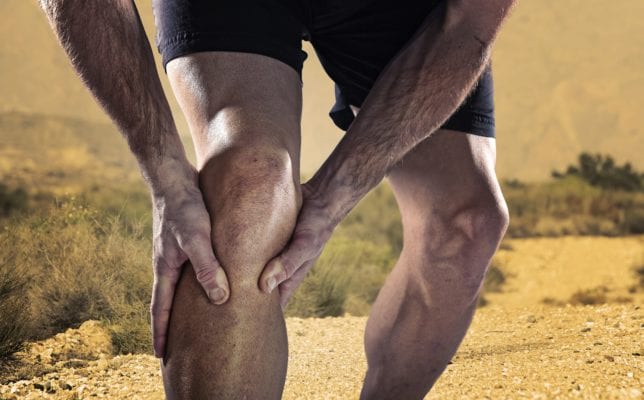
Athlete Experiencing Arthritis Pain
Uric acid is a substance that is created when chemical compounds found in food, known as purines, break down and are dissolved into the blood.1 It is produced as a byproduct of protein digestion and typically excreted by the kidneys through urine.
But if the body produces too much uric acid or the kidneys don’t eliminate enough of it, severe joint conditions may result.
How Uric Acid Forms & Uric Acid Accumulation
Purines contribute to the building blocks for DNA and RNA; however, the uric acid it produces has no useful function in the body.2 Uric acid builds up in the blood but will accumulate around the joints when it can’t pass through the body as needed.1 A physician can conduct a uric acid test to measure the amount of the substance in the blood to diagnose gout and possible causes of kidney stones.3,4
Foods That Cause Uric Acid Build-Up
Diet and nutrition play a role in uric acid levels in the body, and too much of it in the blood results in a condition known as hyperuricemia.5,6 Foods that contribute to uric acid buildup include dried beans, liver, gravies, and anchovies. Other high-purine foods are scallops, asparagus, mackerel, and mushrooms.
Alcohol interferes with the way that uric acid is excreted from the body, so high levels of alcohol consumption can lead to joint problems as well.7 Common triggers of uric acid buildup related joint pain also include dehydration and fructose-sweetened beverages.8,9
Exercise and Lifestyle Habits That Affect Uric Acid Build-Up
An individual’s lifestyle also contributes to the amount of uric acid build-up in the body. Determining factors include body weight, gender, age, genetics, lead exposure, and certain medications.6,10 The amount of exercise that one engages in on a regular basis also affects uric acid build-up.11 It is recommended to maintain a healthy weight and lose weight if necessary.5,6
However, low-carbohydrate diets with high uric acid should be avoided because carbohydrates help the body burn its own fat, and substances known as ketones form when the carbohydrate intake is not sufficient. These substances can increase uric acid levels in the blood even during periods of weight loss. Some medications, such as niacin and diuretics, have shown to boost uric acid levels.12
Why Uric Acid Build-Up Causes Joint Pain
When uric acid is not properly excreted from the body, it is deposited as needle-like crystals in the joints and soft tissues.1,3 This causes inflammation, swelling, stiffness, pain, and heat in the joints. Gout is an extremely painful joint condition that is caused by an excess of uric acid in the joints.6,11 It is an acute form of arthritis that often occurs in one joint at a time.
Uric acid build-up joint pain frequently occurs abruptly at night and can even cause flu-like symptoms, fever, and muscle aches.13 It is typically the most severe during the first 12 hours, lasts between a few days to a few weeks, and spreads on to additional joints over time.
For all types of arthritis pain, including joint pain caused by uric acid build-up, try JointFlex to keep moving all day long. This over-the-counter solution provides immediate and long-lasting relief for arthritis sufferers and athletes in every part of the body.
REFERENCES for URIC ACID AND JOINT PAIN
1. Uric acid – blood. MedlinePlus. Retrieved October 17, 2018 from https://medlineplus.gov/ency/article/003476.htm.
2. Frank, J. (2014 February 26). What are purines? Veritas Health. Retrieved October 18, 2018 https://www.arthritis-health.com/types/gout/what-are-purines.
3. Gout. MedlinePlus. Retrieved October 18, 2018 from https://medlineplus.gov/gout.html.
4. Uric Acid. American Association for Chemical Chemistry. Retrieved October 18, 2018 from https://labtestsonline.org/tests/uric-acid.
5. Arthritis and diet. Better Health Channel. Retrieved October 18, 2018 from https://www.betterhealth.vic.gov.au/health/conditionsandtreatments/arthritis-and-diet.
6. Edwards, N. L. (2018 May). Gout. The Merck Manual. Retrieved October 18, 2018 from https://www.merckmanuals.com/home/bone,-joint,-and-muscle-disorders/gout-and-calcium-pyrophosphate-arthritis/gout.
7. Choi, H. K. & Curhan, G. (2004 December 15). Beer, liquor, and wine consumption and serum uric acid level: the Third National Health and Nutrition Examination Survey. Arthritis and Rheumatism, 51, 1023-1029. Retrieved October 19, 2018 from National Center of Biotechnology https://www.ncbi.nlm.nih.gov/pubmed/15593346.
8. Best Beverages for Arthritis. Arthritis Association. Retrieved October 18, 2018 from https://www.arthritis.org/living-with-arthritis/arthritis-diet/best-foods-for-arthritis/best-beverages-for-arthritis.php.
9. DeChristopher, L.R., Uribarri, J. & Tucker, K. L. (2016 March). Intake of high-fructose corn syrup sweetened soft drinks, fruit drinks and apple juice is associated with prevalent arthritis in US adults, aged 20–30 years. Nutrition and Diabetes, 6, e199. Retrieved October 18, 2018 from National Center of Biotechnology Information https://www.ncbi.nlm.nih.gov/pmc/articles/PMC4817078/.
10. Singh, J. A., Reddy, S. G., & Kundukulam, J. (2011 March). Risk factors for gout and prevention: A systematic review of the literature. Current Opinion in Rheumatology, 23, 192-202. Retrieved October 19, 2018 from National Center for Biotechnology Information https://www.ncbi.nlm.nih.gov/pmc/articles/PMC4104583/.
11. Gout. Centers for Disease Control and Prevention. Retrieved October 19, 2018 from https://www.cdc.gov/arthritis/basics/gout.html.
12. Pascual, E. & Perdiguero, M. (2006 August). Gout, diuretics and the kidney. Annuals of Rheumatic Diseases, 65, 981-982. Retrieved October 19, 2018 from National Center for Biotechnology Information https://www.ncbi.nlm.nih.gov/pmc/articles/PMC1798242/.
13. Crosson, J. R. (2014 October 9). 5 Unusual Gout Symptoms. Veritas Health. Retrieved October 19, 2018 from https://www.arthritis-health.com/types/gout/5-unusual-gout-symptoms.
